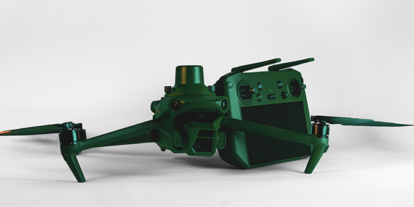2018 was an exciting year for the commercial drone industry. There were some unexpected positive developments – like a full five year FAA Reauthorization with explicit and specific mandates to further progress on commercial drone use and integration – accompanied by frustratingly slow progress in areas like Remote ID and routine advanced operations.
Remote ID will be one of the hottest topics in commercial drones in 2019 because it is the key to unlocking advanced, higher-ROI operations and increasing public support of commercial drone operations at scale. 2019 will be exciting in part because we see Remote ID finally becoming a reality.
The concept of Remote ID is a system to locate and identify the operator of a drone while it is airborne – essentially a digital drone license plate. Customers and partners from a broad spectrum of industries and sectors are driving demand for this critical technology with high impact use cases and compliance needs being the primary drivers.
With this in mind, we want to make some predictions on where progress will be made and why Remote ID is so exciting for the commercial drone industry.
Prediction 1: You will see the FAA mostly complete their rulemaking process on Remote ID, which would describe how to implement systems for the remote identification of UAS operating in the national airspace.
Part of this rulemaking by the FAA will be that it will require all drones operating commercially (and nearly every hobbyist) to be equipped with some minimum form of Remote ID capability. The reason we will see progress on Remote ID in 2019 is because law enforcement concerns about more routine commercial drone operations are addressed by requiring near-universal Remote ID.
It seems that all the main stakeholders (the FAA, commercial operators, law enforcement, and the general public) understand that Remote ID is the key to safely allow more advanced operations and drone use to reach critical mass.
Prediction 2: You will see fully developed, implementable technology standards that industry will adopt in increasingly large numbers.
While standards development is not the most exciting area of policy, no list of predictions would be complete without acknowledging the significant work of standards organizations like ISO and ASTM in 2018. After a lot of progress this year, both groups should be releasing fully-developed standards for UAS operations including Remote ID in 2019. This is exciting because it is easier to build features and products, and reach critical mass adoption with standards behind you.
Prediction 3: You will see Remote ID solutions become standard security measures – deployed at major events and in sensitive areas to track and identify potential security threats.
More widespread use of Remote ID will also force us to have conversations about its effects on law enforcement, privacy concerns about intrusiveness and tracking, and the role of state/local government in drones. At major events, you will see on-site security using systems that provide real-time awareness, identification, and tracking of drones in the area.
One cautionary prediction for Remote ID is that even though airspace is regulated solely by the FAA, Remote ID deployments by state or local government officials could lead to airspace power-grabs by non-federal officials or property owners wishing to limit access to the airspace above them or to enforce bans on drone operations.
Prediction 4: If Remote ID rulemaking and implementation stay stalled, you will see preemptive action to develop proprietary Remote ID systems that protect enterprise investments in drone operations.
Companies won’t wait on rules forever. In the absence of rules, companies would make their own solutions – which would likely be proprietary. Such “closed” systems would be less valuable to the overall industry because network effects make open systems more scalable, resilient, and transparent.
Remote ID will be widely adopted not only because it will be required, but because it is a competitive advantage to do so. In enterprise operations, simply clearing the bar is not good enough. Commercial operators want to be best-in-class on compliance and stay ahead of the next compliance curve. For them, Remote ID will lead to more granular data records, more transparency, operational certainty and further proof of compliance.
Prediction 5: You will see the first data theft from an airborne drone and a real-life counter-UAS system utilizing a form of Remote ID.
Remote ID will open up enormous possibilities for commercial drone operations. There may be some unintended consequences of mandatory adoption of Remote ID systems.
For example, since drones are increasingly sophisticated data-capture devices with increasingly valuable data, they are an increasingly more attractive target for interference. It is not difficult to imagine that tracking technology might be hacked or used for other nefarious purposes. This is why data and network security rightfully dominate conversations about Remote ID.
The easier it is to identify and track airborne drones, the easier it is to launch counter-UAS measures and non-cooperating drones. The capability of these systems will increase, but the question of what measures can be deployed will be limited by regulation and debated more intensely in 2019.
Andrew Elefant
Andrew Elefant is the Director of Legal & Policy at Aloft, an enterprise drone software company. Andrew is a licensed attorney in California. He is also an experienced Private Pilot with Instrument and Multi-Engine ratings, as well as a certificated Remote Pilot.



